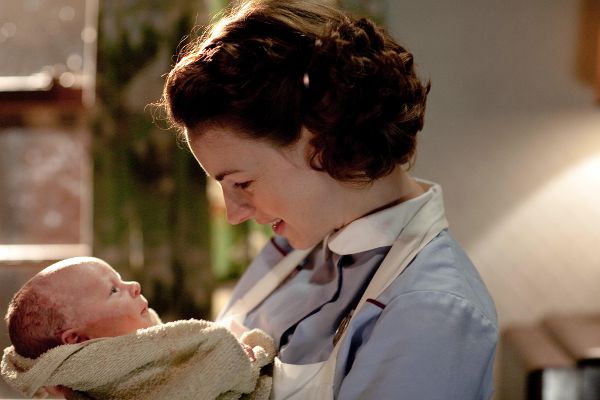This is the first in a series of guest blog posts by the faculty of the Vanderbilt School of Nursing about the previous night’s episode of Call the Midwife airing on Sundays on NPT and PBS Stations natiowide at 7:00 p.m. Central, September 30-November 4. Check in here every Monday morning for the next six weeks for historical and contemporary context on the show, and some fun discussion. SPOILER ALERT: Some, like this one, may can contain spoilers, so please be aware of that.
In the first episode of Call the Midwife, Jenny Lee (Jessica Raine) seems to embody the very best of an eager new midwife. She enters into the story with a sense of innocence and is immediately faced with the harsh realities of caring for the underserved. You can almost see the “layers” come off of her as she begins to look around and accept the less than beautiful setting of her first job. Getting covered in ash and soot from the fireplace of her first birth with the Sisters seems to be a perfect metaphor: you can’t do this job unless you’re willing to let things be messy. Midwifery is messy. Sometimes there are not easy answers, and it becomes more about the journey then the end point.
Even as she faces repulsive realities, she accepts the invitation to be present for the women that she is caring for: Conchita and her preterm baby who she insists is better off in her arms than a hospital; Pearl and her sexually transmitted infection; and Muriel with her less than lovely home birth. She makes the choice to look at each unfolding situation through the lens of the woman, recognizing them as the true heroine (and not herself). In this way, she’s not much different than midwives today. Despite many advances in the care of women and children, we are still facing harsh realities. Midwives meet these challenges with heart and determination, merging practice and science with the art of midwifery care.
As the first episode comes to a close, you start to feel Jenny come alive to her surroundings – just like Conchita’s preterm baby shows signs of life by moving his little arms and legs in the bassinet. She starts to feel all the emotions she is having, but she doesn’t just dwell on the tough ones. Amidst the poverty and heartache in the communities of East London, she starts to see the possibilities and the power of connection. She acknowledges the importance of love: love from a mother to a baby, love from a husband to a wife, love from a midwife to the woman she serves. This is the transformation into midwifery that is always hard to explain, but I think all who know this profession well will say it’s the most important thing we do.
Margaret Buxton, MSN CNM, is a Certified Nurse-Midwife, Instructor of Nursing, Vanderbilt School of Nursing and Clinical Practice Director, West End Women’s Health Center.


5 Comments
Several of us have been wondering about the rectal tube in the midwife’stravel bag. We looked it up online and it was said to be used to “relieve excessive or chronic flatulence”, but we still can’t figure out when or where it was used. Ideas?
Thanks,
Melissa, CNM
I googled this too! I read an interview with the cast and producers, who described the rectal tubes as being used to administer the enema solution.
I think that it is great that none of us practicing midwives knew what it was used for! Whew!
Karen, CNM
I wonder why the writers did not include any babies being fed except the premature one with the pipelle. Surely breastfeeding was commonplace…is breastfeeding more graphic than birth!?! Just wondered if others also noticed this ommission…
I wonder why Jenny and later Chummy are so surprised that the rectal tube is glass. Did they already use rubber in hospitals?
I noticed the cords being cut before it turned white and babies being wrapped immediately before skin to skin. I suppose that was what they used to do in England and was a practice pushed across the world… glad things are changing